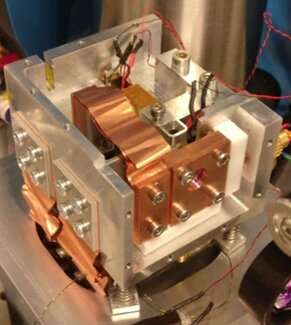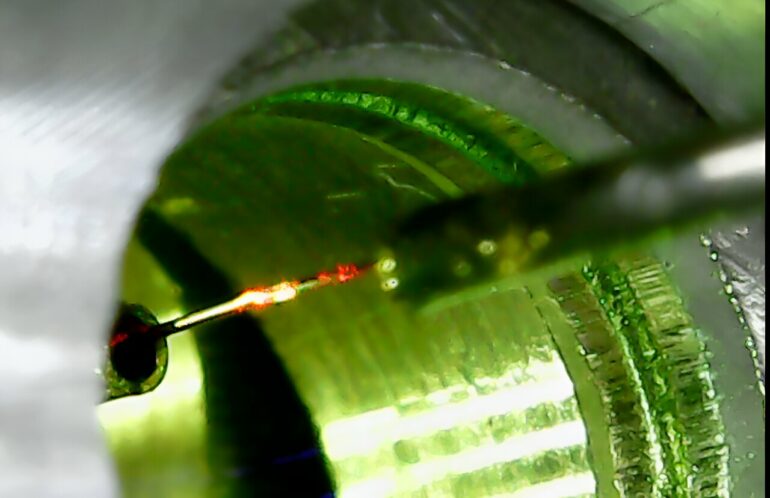Processing quantum information relies on interacting qubits—the basic building blocks of quantum information—to perform computational tasks. Scientists are searching for the optimal qubit platform that can perform operations more efficiently, accurately and as fast as possible.
With the additional goal of interfacing a quantum processing system with a quantum network, a system able to generate entanglement between long-lived matter qubits and photons is the most desirable, allowing for a low-loss and fast interface between the nodes of the future quantum internet.
Qubits can be fabricated with superconducting circuits, trapped atoms and ions, or even defects in solids. Quantum information is encoded in a degree of freedom of the physical system, such as the electronic state of an ion, e.g. “0” if the ion is in the ground state and “1” if the ion is in the excited state. Because it is a quantum system, the qubit can also be placed in any superposition of these two states. Some qubits can also interact with each other, for example through electric or magnetic fields dependent on their state.
In past years, qubits realized in solid-state spins have attracted a lot of attention. The qubits are naturally trapped in the matrix of the solid, such as diamond or silicate crystals, and if placed close to each other they can be made to interact, creating what are called qubit-qubit gates. Many can also be read out through the emission of a photon, allowing for the generation of spin-photon entanglement.
Distinguishing single ions in an ensemble
However, these requirements are pushing the experiment in different directions. Finding single qubits in a solid requires a matrix with a low concentration of spins to make sure that they are all spectrally separated and can then be addressed individually. At the same time, such a low density would increase the average distance between spins, resulting in a low interaction between the ions, which is the necessary tool for qubit-qubit gates.
In recent years, researchers have found that rare-earth ion-doped crystals provide a robust system and reliable platform for light-matter interaction. The ions are trapped in the solid-state matrix and have long coherence times and different ground states where qubits can be encoded.
Moreover, neighboring ions interact with one another through dipole-dipole interactions. If one were able to look into and analyze a small region of the crystal, small enough to contain a number of atoms suitable for single ion detection while not affecting the density, then all the required conditions would be met.
In a study published in Optica, ICFO researchers Chetan Deshmukh, Eduardo Beattie, Bernardo Casabone, and Samuele Grandi, led by ICREA Prof. at ICFO Hugues de Riedmatten, in collaboration with researchers Diana Serrano, Alban Ferrier and Philippe Goldner from Institute de Recherche de Chimie de Paris, and David Hunger from Karlsruher Institute fur Technologie have come up with an ingenious way of doing just this.
They have reported the first demonstration that shows how single rare-earth ions have been addressed and detected in an ensemble of atoms within a nanoparticle that has been coupled to a fiber-microcavity, which allows for an efficient light-matter interaction. In their experiment, the ions used were erbium ions emitting single photons at telecommunication wavelength and packed in a volume two orders of magnitude smaller than in previous realizations.

The home-built nanopositioner used to move the fiber in three dimensions over the surface if the mirror. © ICFO/E. Beattie
Not too far, not too close
When you try to excite an over-dense ensemble of ions, the excitation frequency of a given ion will be so close to that of others that their spectrum will overlap. In these conditions, exciting one ion invariably leads to the excitation of others as well. This hampers the possibility of addressing individual ions.
However, in nanoparticles, the density of the ions can be kept high because the volume is very much reduced and, thus, the total number of ions is limited. While the average physical distance between ions remains low, the difference between their frequencies is high enough to actually make them fully distinguishable. A full constellation of interacting ions can then be found inside the nanoparticle, which could become a small quantum information processing system.
Now, in their experiment, the team first grew nanoparticles with an average diameter of 150 nm doped with erbium ions, where each nanoparticle contained approximately 1000 Er ions. They then placed the nanoparticles on a mirror and cooled them down to ~6 K.
The mirror acted as one part of an optical cavity, with the other being a curved mirror fabricated on an optical fiber. Both the mirror and fiber could be moved in three dimensions, allowing for the selection of arbitrary nanoparticles scattered over a wide area. When the fiber was aligned with a nanoparticle, a cavity was formed.
The erbium ions were excited with a laser at 1,535 nm, and their emission was collected through the fiber cavity. The cavity increased the interaction between light and matter, resulting in a faster emission of the ions through the Purcell effect, and a higher collection efficiency. The authors measured an increase in the emission of the ions by more than a hundred, of which more than 99% were in the cavity mode.
By observing the fluorescence signal through the ensemble of ions, they were able to see different bright and narrow peaks of emission in a nanoparticle. Focusing on one of them, they set to establish whether this was indeed a single emitter.
The first sign they looked for was a saturation in the probability of detecting a photon for increasing excitation power. This comes from the fact that the ion has to be in the excited state to be able to decay and emit a photon. However, the ion does not decay immediately, but rather after a specific time, which is known as its lifetime. This limits the number of times that the ion can be excited, and therefore its probability of emission.
Bearing this in mind, the authors were able to detect this effect and measure it but saw that they could saturate the ion with only ~10-2 photons in the cavity per cavity lifetime, proof of a strong interaction between light and matter. The most apparent sign of a single ion though is the fact that it can emit only one photon at a time.
This property can be tested by dividing the emission of the ion equally between two detectors, and checking that only one would click at any given time, since a stream of single photons could not lead to simultaneous detections. The authors confirmed this property as well, providing a final solid proof that they were indeed detecting emission from a single ion.
The results of this study “may enable a new way of achieving quantum processors using hundreds of qubits in a nanoscale volume, which can be detected and manipulated individually and efficiently coupled to single photons for quantum networking” says Eduardo Beattie, researcher at ICFO co-first author of the study.
As ICREA Prof. at ICFO Hugues de Riedmatten concludes, “The possibilities that individual rare-earth ions in nanoparticles offer are manifold: erbium ions could provide communication qubits to connect quantum processors while other species could provide processing qubits. Moreover, the fully fiber-integrated system that we have developed is an important step towards the realization of future quantum hardware.”
More information:
Chetan Deshmukh et al, Detection of single ions in a nanoparticle coupled to a fiber cavity, Optica (2023). DOI: 10.1364/OPTICA.491692
Citation:
Single ions in nano-sized particles: A new platform for quantum information processing (2023, November 21)



